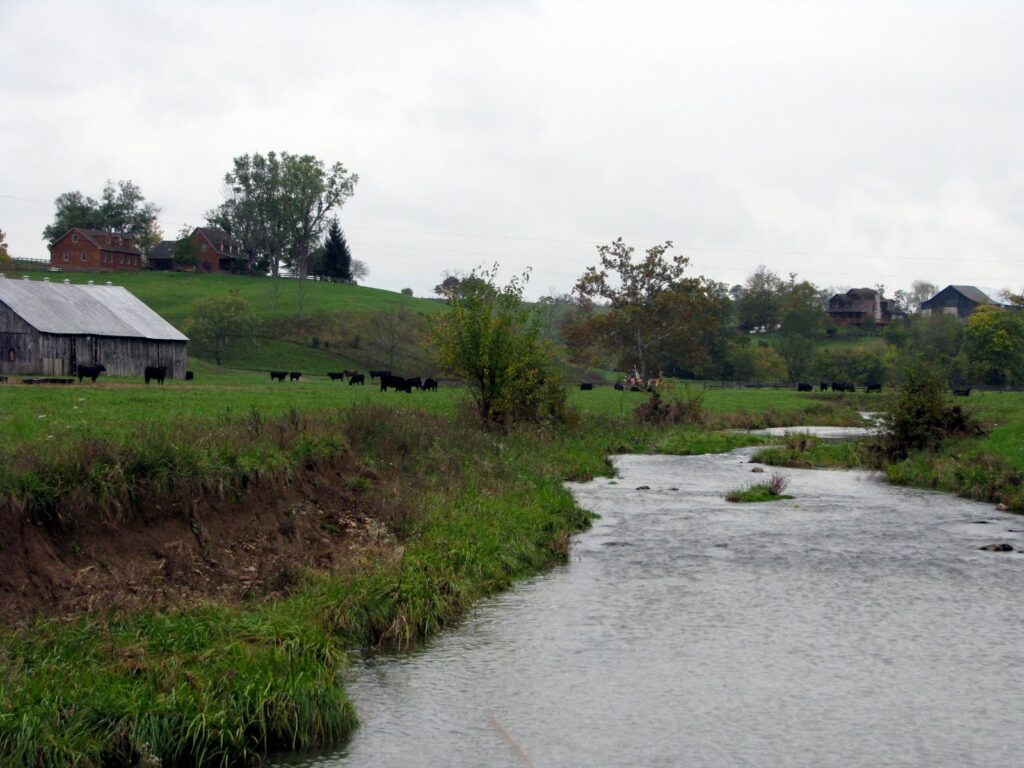Category: Uncategorized
No Destination: First Presbyterian Church of Mount Sterling
 Traveling Kentucky’s counties in the fall is a risky proposition. You never know when you might run into a county’s fall festival. This was the case yesterday: Court Days in Mount Sterling.
Traveling Kentucky’s counties in the fall is a risky proposition. You never know when you might run into a county’s fall festival. This was the case yesterday: Court Days in Mount Sterling.
All on-street parking was closed and I pulled into the lot of the Presbyterian Church (pictured above). The man said that I could not park there without paying, even if it were only for a few minutes. Note: he had no customers. Instead, I turned around and parked in a lot around the corner. The woman in that lot said that I could park there momentarily with no trouble and she pointed me toward the Courthouse.
I walked around Mount Sterling and returned to snap a few pictures of the Presbyterian Church. The man from earlier apologized; I told him it was not a problem and that a kind woman around the corner had allowed me to park gratis. I joked with him that he had “married up,” as it was his wife managing the lot around the corner.
The wife also told me about the Presbyterian Church. Next door to the church is the “Presbyterian Post,” (pictured below) which functions as additional space for the church, a community center and a community medical clinic. The Post is the old Post Office – likely constructed around 1910 and purchased by First Pres in 1991.

No Destination: Mount Sterling
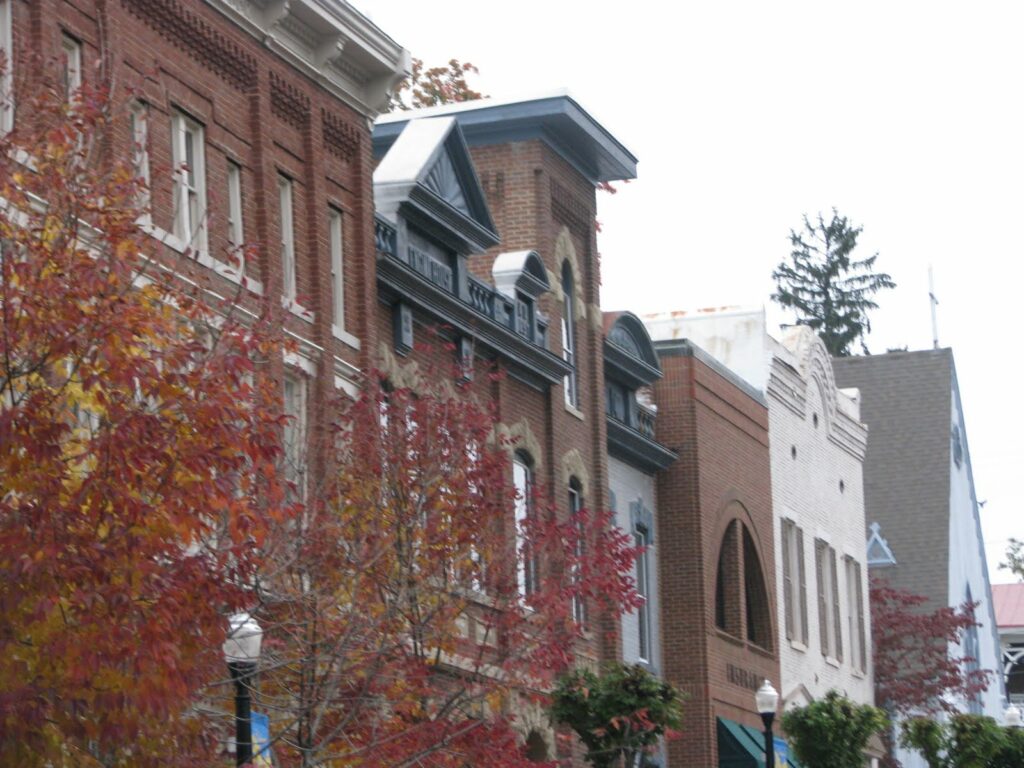 When Nate visited the Montgomery County courthouse, he was underwhelmed by the courthouse but very impressed with the “painstakingly restored” buildings in Mount Sterling. I couldn’t agree more. The historical preservation and adaptive reuse in this community.
When Nate visited the Montgomery County courthouse, he was underwhelmed by the courthouse but very impressed with the “painstakingly restored” buildings in Mount Sterling. I couldn’t agree more. The historical preservation and adaptive reuse in this community.
One building, with markings of “Engine House,” “City Court,” and “Library” now has a banner in front noting the new home of the Montgomery County Historical Museum. The old city jail, “The Bell House,” was constructed in 1815 and restored around 1990 by the local historical society.
Mount Sterling was a regular scene of Civil War activity. Possession of the city changed a dozen times during the War; the courthouse was burned by Confederate forces in December of 1863; the Battle of Mount Sterling (March 22, 1863) resulted in only 12 deaths, but resulted in the capture of 438 prisoners and significant Union supplies; and in June 1864, Gen. Morgan and his horsemen took the vault key from the cashier of Farmer’s Bank and left town with over $60,000.
One of Morgan’s men (Lt. Witherspoon) was tried in a civil action in 1866, but the judgment against Witherspoon was reversed on appeal because robbery was not unlawful under the laws of war.
Map Update
Red River Gorge
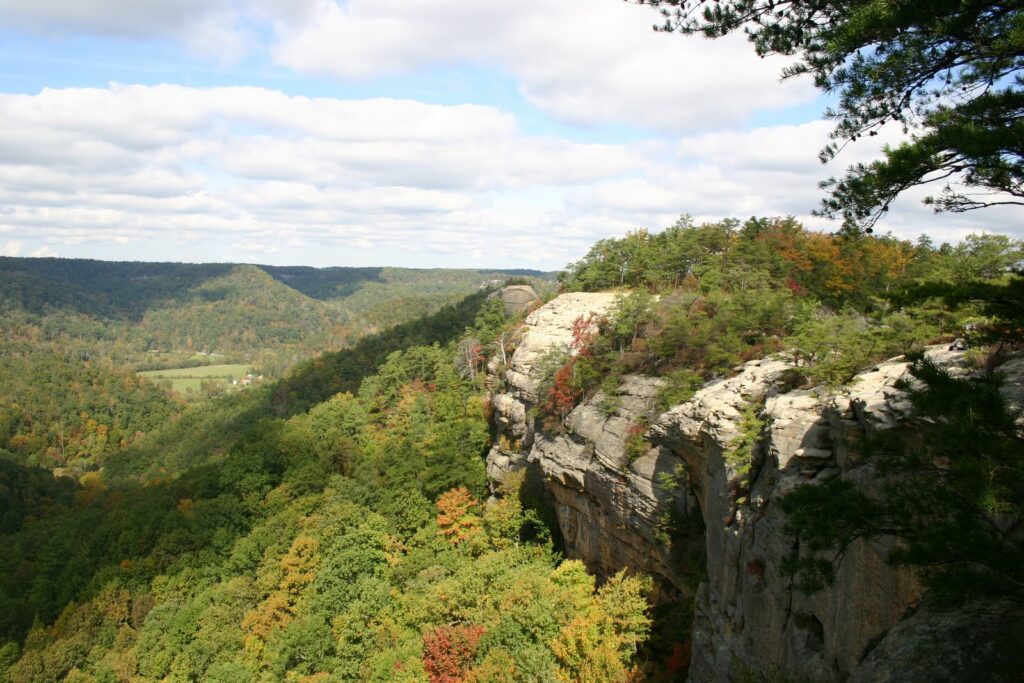 I know I’m only supposed to do the Kentucky 120 posts, but last weekend my wife and I hiked the Auxier Ridge up to Courthouse Rock in the Red River Gorge. For those local Kentuckians who may have never been to the Gorge, you really should get up there. The hiking is especially good this time of year, with the cooler temperatures and the leaves changing color.
I know I’m only supposed to do the Kentucky 120 posts, but last weekend my wife and I hiked the Auxier Ridge up to Courthouse Rock in the Red River Gorge. For those local Kentuckians who may have never been to the Gorge, you really should get up there. The hiking is especially good this time of year, with the cooler temperatures and the leaves changing color.
According to the site redrivergorge.org, the park contains more than 80 natural arches, many endangered or threatened species and rock shelters that the Native Americans and Daniel Boone used for shelter. It’s really a beautiful place that is shockingly close to Lexington and easily accessible.
walkLEX: Cheapside Park
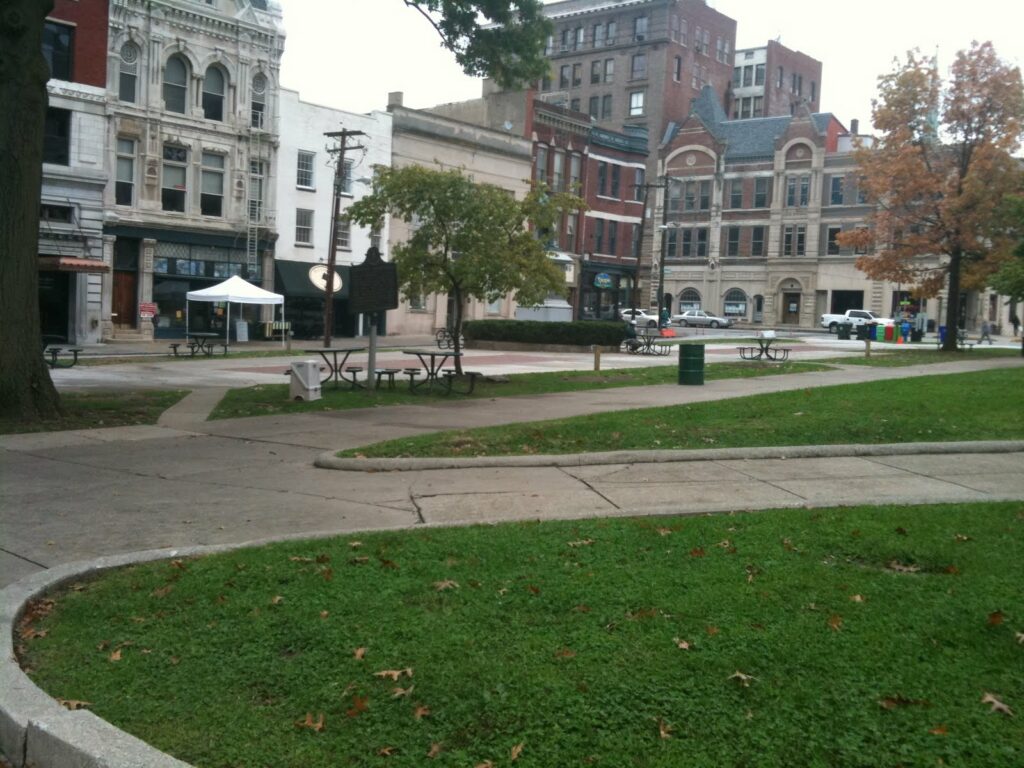 Next to the old Fayette County Courthouse lies Cheapside Park. The park was expanded last year by the closure of a narrow street and the elimination of several on-street parking places. It was a great decision as many of the businesses along the park have added sidewalk dining and many downtown area brown-baggers (including yours truly) visit the park and its tables during our lunch hours.
Next to the old Fayette County Courthouse lies Cheapside Park. The park was expanded last year by the closure of a narrow street and the elimination of several on-street parking places. It was a great decision as many of the businesses along the park have added sidewalk dining and many downtown area brown-baggers (including yours truly) visit the park and its tables during our lunch hours.
Beginning next month, construction will begin on the Fifth-Third Pavilion, a glass and steel structure that will house the Lexington Farmer’s Market (as well as other functions and events). Cheapside Park has truly become a downtown center of commerce and activity (much as it was in its early history, though it was then used for the sad purpose of trading slaves). Pictured above is how Cheapside Park appears today; pictured below are artists rendering of Cheapside Park as it will appear next summer.


New Comment Policy
A quick note to our readers: Comments are now open to all, including those wishing to remain anonymous. Hopefully, this will increase the number of those commenting. In order to keep this site G-rated from being filled with Viagra ads and advertisements hocking questionable wares, however, I will moderate comment postings. Comment!
No Destination (& Kentucky 120) Progress Maps

After my October 4 journey through Bourbon, Nicholas, Robertson, Mason and Bracken Counties (I also quickly drove through Harrison County, but without time to meander and stop for pictures – thus, it doesn’t count), I have visited 22 of Kentucky’s 120 counties (or 18.33%).
This coming weekend, my wife’s grandfather would have celebrated his 100th birthday. He passed several years ago, but we will be traveling to Carter County to celebrate. I am going to drive separately and look forward to adding to my count.
Below is a map of Nate’s and my combined journeys. Counties visited by Nate alone are in Red; those visited by me alone are in Yellow. Counties visited by both of us are in Blue.
No Destination: Augusta
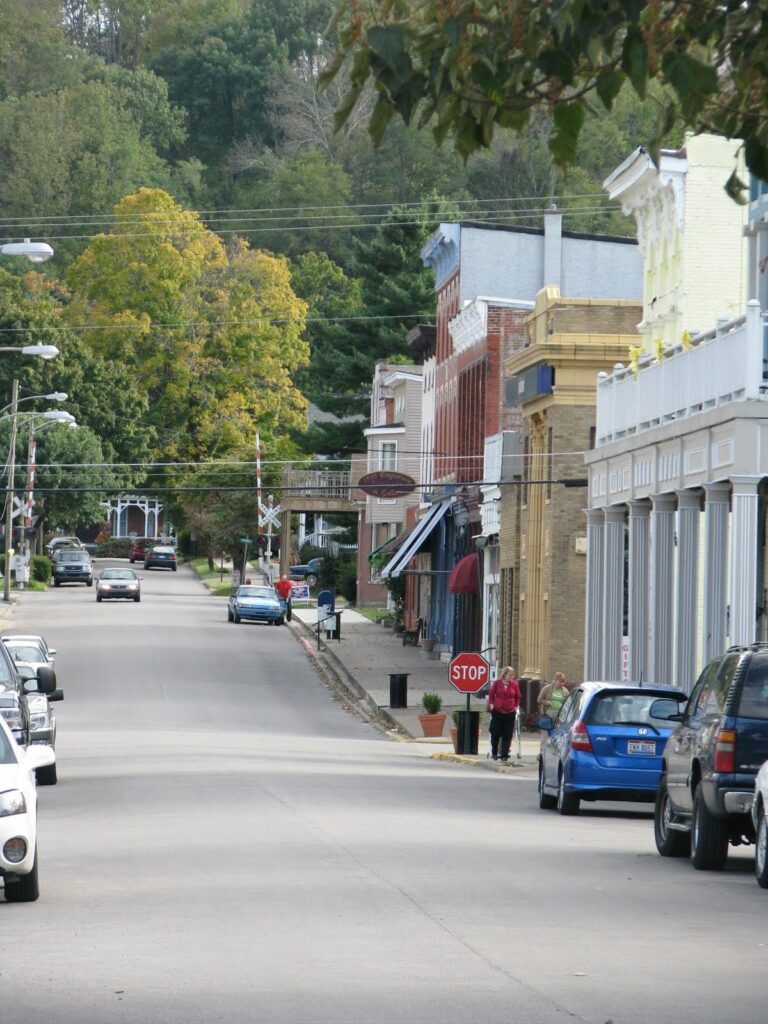 Kentucky history laureate, the late Dr. Thomas Clark listed Augusta as one of Kentucky’s Eleven Treasures that Helped Shape the Commonwealth. Augusta is a fine town on the Ohio River of over 2,000 people. Because I arrived in Augusta in late afternoon, I plan to return so that I might spend more time in this community.
Kentucky history laureate, the late Dr. Thomas Clark listed Augusta as one of Kentucky’s Eleven Treasures that Helped Shape the Commonwealth. Augusta is a fine town on the Ohio River of over 2,000 people. Because I arrived in Augusta in late afternoon, I plan to return so that I might spend more time in this community.
Augusta was the county seat of Bracken County from the creation of the county until the seat was moved to the more centrally located Brooksville in 1839. While this may seem unusual today, Bracken County was once quite large geographically. It contained parts of what is now Bracken, Robertson, Harrison (eastern), Bourbon, Nicholas (most) and Mason (southern) counties.
The town is in terrific condition (especially when compared to neighboring Dover). On a Sunday afternoon, tourists were in great number and shops were open. Though no longer the county seat, Augusta is the center of Bracken County life.
Augusta has much to owe its most famous residents: the Clooneys. Rosemary Clooney owned a summer home in Augusta, while her brother (journalist, newsanchor and gameshow host Nick) continues to live in Augusta. Of course, it is Nick’s son (actor George) who is today’s most well-known Clooney; George attended and graduated from the Augusta High School (pictured below).
 Augusta is also the home of Miss America 2000, Heather Renee French (Henry).
Augusta is also the home of Miss America 2000, Heather Renee French (Henry).
No Destination: Dover
 Founded in 1818 and incorporated in 1856, the Mason County community of Dover lies just north of the AA-highway and on the Ohio River.
Founded in 1818 and incorporated in 1856, the Mason County community of Dover lies just north of the AA-highway and on the Ohio River.
Here is a description, c. 1860: “The village contains several churches, large steam flouring and saw mills, some twelve or fifteen stores and tobacco warehouses, and an equal number of mechanical trades. Population about 900.”
In 1963, “A beautiful town, located on a fertile plateau with a population of just over 700. It has a general store, schools, a fine youth centre, seven churches, a City Marshall, or policeman; a Police Judge and 24 volunteer firemen. The city is also excited as the mighty duPont has acquired 1,000 acres of land for industrial development.”
Then, April 23, 1968. A tornado destroyed 115 of the town’s 127 homes. Only three churches were rebuilt. All students were sent to Maysville for school and the city no longer offers city services. And duPont never built its factory. Despite the 328 residents (est. 2008), Dover remains a ghost town.

